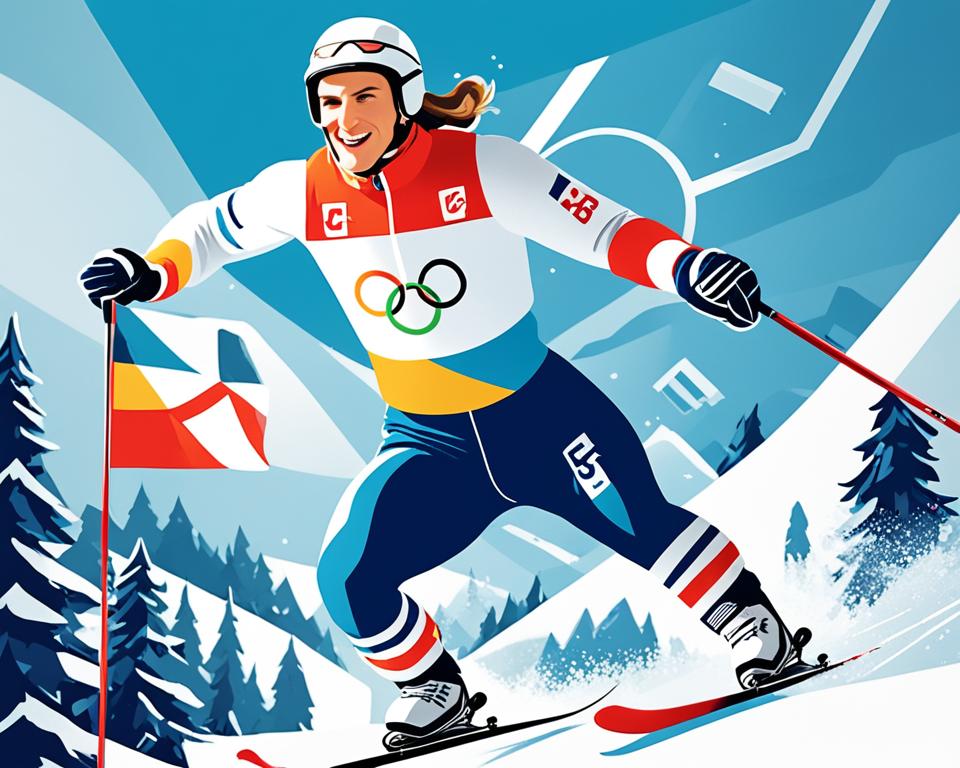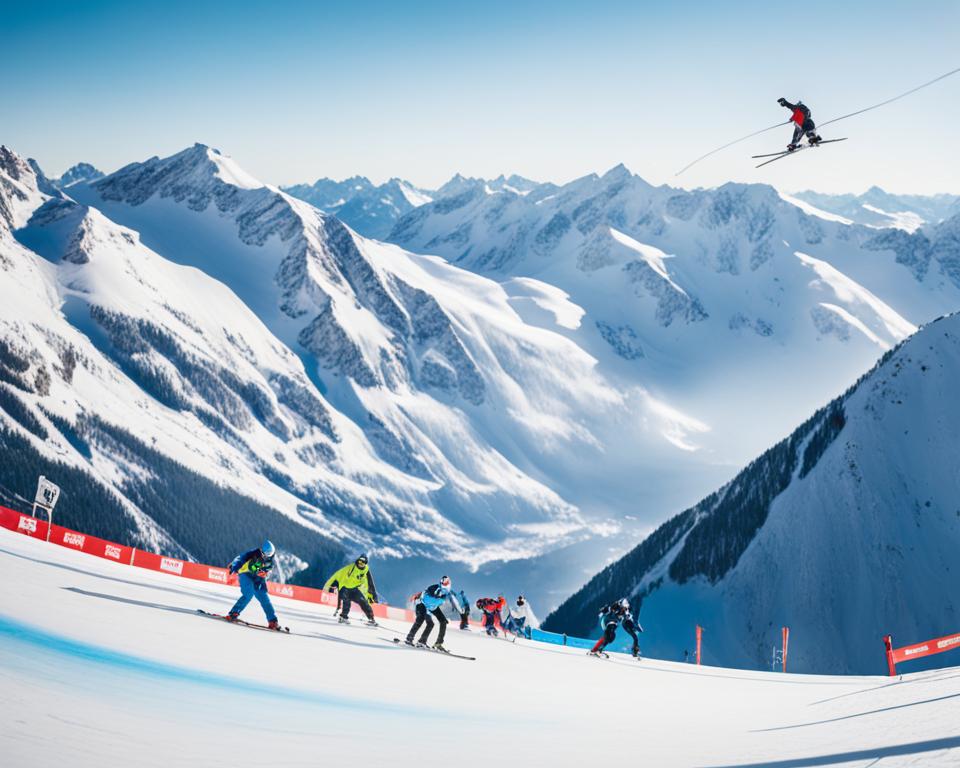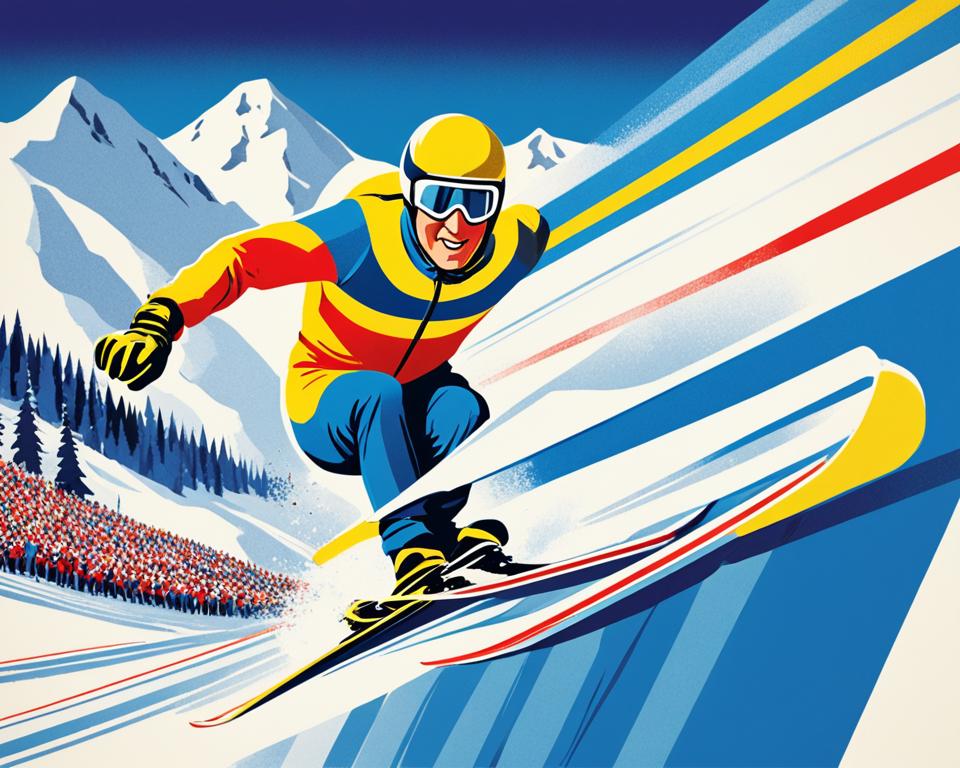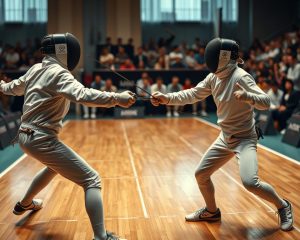
The 1936 Winter Olympics took place in Garmisch-Partenkirchen, Germany. It was a key event in winter sports history. Athletes from around the world showed their skills in events like alpine skiing and figure skating.
The games were memorable for their thrilling competitions and beautiful performances. They left a lasting impact on winter sports.
However, the games were also marred by controversy. The Nazi regime’s role raised concerns about propaganda. Yet, the 1936 Olympics are still celebrated for their focus on human spirit and athletic excellence.
This article will explore the 1936 Winter Olympics in detail. We’ll look at the sports, the Olympic torch relay, and the achievements of athletes like Jesse Owens. Discover the stories and impact of this important event in winter sports history.
Read more interesting information at ::102aoki
Hosting the 1936 Winter Olympics in Garmisch-Partenkirchen, Germany
The 1936 Winter Olympics took place in Garmisch-Partenkirchen, Germany, a year after the Nazis took power. Hosting the games was a chance for the Nazis to show off Germany to the world. They wanted to spread their ideology through the event.
Nazi Propaganda and Controversies
The Nazis worked hard to use the 1936 Winter Olympics for their propaganda. They wanted to show Germany as perfect and its people as united. But, their actions were criticized for being discriminatory and violating human rights.
Preparing the Winter Sports Venues
Before the 1936 Winter Olympics, Garmisch-Partenkirchen changed a lot to welcome athletes and fans. They improved and built new sports venues, like the famous Garmisch-Partenkirchen Olympic Ice Stadium. This made the town ready for the best winter sports athletes.
| Venue | Event(s) Hosted | Capacity |
|---|---|---|
| Garmisch-Partenkirchen Olympic Ice Stadium | Figure Skating, Speed Skating | 12,000 |
| Gudiberg Ski Jump | Ski Jumping | 20,000 |
| Kreuzjoch Downhill Run | Alpine Skiing | N/A |
“The 1936 Winter Olympics in Garmisch-Partenkirchen provided a perfect stage for the Nazi regime to showcase their country and promote their ideology. However, the controversies surrounding their efforts to manipulate the event cast a long shadow over the games.”
The Olympic Torch Relay: A New Tradition
The 1936 Winter Olympics in Garmisch-Partenkirchen, Germany, were a big deal in Olympic history. It was there that the olympic torch relay started, becoming a key part of the Games.
The olympic torch relay was meant to link ancient and modern Olympics. It started in Olympia, Greece, and ended at the Garmisch-Partenkirchen opening ceremony. This event amazed people and set the stage for future torch relays.
Symbolism and Spectacle
The olympic torch relay was more than just moving the flame. It was a symbol of the Games’ symbolism and spectacle. As runners carried the flame through cities and towns, it brought people together and built excitement.
- The relay showed the Olympic ideals, with the flame standing for the Games’ spirit.
- The relay’s well-planned processions and famous torch carriers amazed the crowd, setting the stage for the opening ceremony.
- The symbolism and spectacle of the olympic torch relay have become key parts of the Olympic experience. Each Games adds its own special touch to this tradition.
The olympic torch relay started at the 1936 Winter Olympics in Garmisch-Partenkirchen, marking a big moment in Olympic history. This tradition has captured the world’s imagination and shaped the symbolism and spectacle of the Olympics today.
Alpine Skiing Events: Thrills on the Slopes
The 1936 Winter Olympics in Garmisch-Partenkirchen, Germany, were a big deal for alpine skiing events. These events were exciting and set the stage for the growth of skiing events as a top winter sport.
The downhill, slalom, and giant slalom were the main events at the 1936 Games. Skiers showed off their speed and skill as they raced down the mountain. They competed against the clock and each other.
The downhill event was very exciting, with skiers going super fast. The slalom tested their precision and agility as they went through gates. The giant slalom was a mix of speed and technique, needing skiers to make big turns.
| Event | Description | Winning Time (1936) |
|---|---|---|
| Downhill | Skiers navigate a long, steep course at high speeds | 3:25.9 |
| Slalom | Skiers weave through a series of closely spaced gates | 2:20.3 |
| Giant Slalom | Skiers navigate longer, sweeping turns on a longer course | 4:41.4 |
The alpine skiing events at the 1936 Olympics were a hit with the crowd. They showed off the amazing skills and athleticism of the skiers. These events helped make skiing events even more popular over the years.
“The thrill of alpine skiing is unmatched – the speed, the precision, the sheer athleticism on display. The 1936 Winter Olympics captured that excitement perfectly.”
1936 winter olympics: Figure Skating Showcases Grace and Artistry
The 1936 Winter Olympics in Garmisch-Partenkirchen, Germany, was a true showcase for the elegance and skill of figure skating. Spectators were captivated by the athletes’ mesmerizing performances. These combined technical skill with artistic expression. The figure skating competitions at the games were a highlight, featuring some of the most memorable moments of the event.
Memorable Performances
Sonia Henie of Norway shone in the women’s singles event, defending her Olympic title with grace and athleticism. Her spins, footwork, and music interpretation left the audience in awe. The men’s competition was thrilling, with Austria’s Karl Schäfer earning his second gold medal with a captivating performance.
In the pairs event, the German duo of Maxi Herber and Ernst Baier impressed with their synchronized performance and lifts. Their performance showed the artistry and athleticism of figure skating at the 1936 Winter Olympics.
Judging Controversies
The figure skating competitions had their share of judging controversies. The subjective scoring system led to some questionable decisions. These judging controversies added drama to the events, keeping audiences engaged and invested in the outcomes.
The 1936 Winter Olympics figure skating competitions showcased the finest in figure skating performances and figure skating competitions. They captivated the world with their grace, artistry, and occasional judging controversies. These events made figure skating a beloved part of the Winter Games.
Speed Skating: Records Shattered on Ice
The 1936 Winter Olympics in Garmisch-Partenkirchen, Germany, was a thrilling event for speed skating. Athletes showed their amazing skills and willpower as they raced against time. They broke records and amazed everyone watching.
Speed skating has always been a key part of the Winter Games. In 1936, fans were excited to see the world’s fastest skaters compete. The events were full of intense rivalries, close finishes, and new records that inspired future skaters.
| Event | Record Holder | Time |
|---|---|---|
| Men’s 500m | Ivar Ballangrud (Norway) | 41.2 seconds |
| Men’s 5000m | Ivar Ballangrud (Norway) | 8:08.6 minutes |
| Women’s 500m | Laila Schou Nilsen (Norway) | 46.2 seconds |
The 1936 Winter Olympics brought us legendary speed skaters like Ivar Ballangrud from Norway. He won the men’s events and set new records. Laila Schou Nilsen, also from Norway, made a big impact in the women’s 500m, setting a record that will be remembered for years.
These amazing performances wowed the crowd and motivated the next generation of speed skaters. The 1936 Winter Olympics’ speed skating events left a lasting impact. They inspired athletes to aim high and make their mark in this exciting sport.
The Debut of Winter Olympic Sports
The 1936 Winter Olympics in Garmisch-Partenkirchen, Germany, was a big step for the Winter Games. It introduced new sports like luge and biathlon to the world stage. These sports made their first appearance at the international level.
Expanding the Winter Games
Luge and biathlon joined the 1936 Winter Olympics, opening doors for more winter sports. Luge is a heart-pounding event where athletes speed down icy tracks. Biathlon mixes cross-country skiing with rifle shooting, showing off athletes’ endurance and aim.
These new sports added variety to the winter olympic sports lineup. They helped make the expanding winter games more popular worldwide. Athletes from all over showed off their skills in these new events, setting the stage for more changes in the future.

The addition of luge and biathlon was a big deal for the Winter Olympics. It helped grow the expansion of the winter games and add more sports. The 1936 Winter Games set the stage for the growth and popularity of winter sports worldwide.
Jesse Owens’ Triumph: Defying Racial Prejudice
The 1936 Winter Olympics in Nazi Germany were filled with racism. But Jesse Owens, an African-American track star, stood out. He won four gold medals, showing the world his talent and strength against racial prejudice.
Owens proved wrong the Nazi belief in Aryan superiority. He won in the 100m, 200m, long jump, and 4x100m relay. This showed that white athletes weren’t the only ones who could win.
“We all have dreams. But in order to make dreams come into reality, it takes an awful lot of determination, dedication, self-discipline, and effort.”
Owens’ triumph was more than personal. It was a message of hope and strength against racism. His story motivates athletes and activists to fight against prejudice and reach their goals.
The 1936 Winter Olympics were marked by Nazism’s dark shadow. But Jesse Owens’ victory will always be a symbol of hope. His story teaches us that true greatness comes from our inner strength, not from hate.
The Legacy of the 1936 Winter Olympics
The 1936 Winter Olympics in Garmisch-Partenkirchen, Germany, made a lasting impact on winter sports. It was more than just a sporting event. It helped shape the future of winter sports, setting the stage for their growth and change.
Impact on Winter Sports
The 1936 Winter Olympics boosted the popularity and development of winter sports. The games featured cutting-edge ski jumps and alpine skiing courses. These innovations sparked a wave of interest in these sports.
After the games, alpine skiing saw a big increase in participants and new ski resorts were built worldwide. Figure skating and speed skating also gained fans, leading to more training programs and new talent.
| Sport | Impact of the 1936 Winter Olympics |
|---|---|
| Alpine Skiing | Increased public interest and the construction of new ski resorts globally |
| Figure Skating | Establishment of dedicated training programs and the discovery of new talent |
| Speed Skating | Heightened enthusiasm for the sport and the development of new techniques and equipment |
The 1936 Winter Olympics left a lasting mark on winter sports. The innovations and infrastructure from Garmisch-Partenkirchen have driven future progress.
“The 1936 Winter Olympics marked a turning point in the history of winter sports, inspiring a new generation of athletes and fans alike.”
Memorable Moments and Highlights
The 1936 Winter Olympics in Garmisch-Partenkirchen, Germany, were unforgettable. They showed memorable moments and iconic athleticism. The games had drama and highlights that amazed people all over the world.
Iconic Athleticism and Drama
One key moment was Norwegian skier Birger Ruud’s win in ski jumping. His jump was so amazing, it won him the gold medal. It showed his athleticism and precision.
The speed skating event was also unforgettable. Skaters broke world records one after another. It was a display of raw power and determination as they raced to beat the clock.
“The 1936 Winter Olympics were a true showcase of the human spirit, where athletes pushed the limits of their abilities and captivated the world with their iconic athleticism and dramatic performances.”
The figure skating was also a big hit. Skaters wowed the crowd with their grace and skill. The routines and the nail-biting judging made the skating a highlight of the games.

These memorable moments and iconic performances made the 1936 Winter Olympics unforgettable. They are a big part of sports history.
Behind the Scenes: Organizers and Volunteers
The 1936 Winter Olympics in Garmisch-Partenkirchen, Germany, were a huge success. This was thanks to the hard work of organizers and volunteers. They worked hard behind the scenes to make the games run smoothly. They planned everything from logistics to managing the crowd.
The German Olympic Committee led the event planning. They turned a small Bavarian town into a top-notch Olympic host. They built sports venues, arranged transport and places to stay for athletes and fans, and managed the event’s complex logistics.
Volunteers also played a big part. Many were locals who gave their time and effort. They did everything from greeting visitors at the train station to helping people find their seats. Their hard work and spirit made the Olympics unforgettable for everyone there.
Organizers and volunteers made sure the Olympics ran smoothly. They managed the torch relay and the sports events perfectly. Their hard work, often unseen, was key to the Olympics’ success.
“The success of the 1936 Winter Olympics was not just a testament to the athletic prowess of the competitors, but also to the dedicated team of organizers and volunteers who worked tirelessly to bring the event to life.”
Winter Sports History and Evolution
The history of winter sports goes way back, rooted in cultural traditions and the challenge to beat the cold. From ice skating and skiing to today’s Winter Olympics, the story of winter sports history is fascinating.
Roots and Development
Winter sports started as ways to get around and survive in snowy places. Skiing helped people move over snow, and ice skating let them cross frozen lakes. Over time, these activities turned into sports for fun and competition.
People wanted to see how far they could go and how fast they could move on snow and ice. This led to the growth of winter sports.
Culture also played a big part in shaping winter sports. Different places developed their own styles and traditions. For example, Nordic countries are known for cross-country skiing, while alpine areas are famous for downhill skiing and snowboarding.
| Winter Sport | Origin | Notable Milestones |
|---|---|---|
| Skiing | Scandinavia | – First recorded ski competitions in the 19th century – Emergence of distinct disciplines like cross-country, downhill, and ski jumping |
| Ice Skating | Netherlands | – Earliest records of ice skating date back to the 13th century – Development of figure skating and speed skating as competitive sports |
| Snowboarding | United States | – Invented in the 1960s, gaining widespread popularity in the 1980s – Inclusion in the Winter Olympics in 1998 |
The story of winter sports history keeps changing, thanks to new technology, changing tastes, and the drive for better performance. This mix of winter sports has won the hearts of people all over the world. It motivates athletes and fans to enjoy the excitement of snow and ice.
Conclusion: Reflections on the 1936 Winter Olympics
The 1936 Winter Olympics in Garmisch-Partenkirchen, Germany, were a key moment in Winter Games history. They introduced the Olympic torch relay and showcased Jesse Owens’ triumph. This event left a lasting impact on winter sports.
The games showed how winter sports were growing and developing. They highlighted the best in athleticism and artistry. Alpine skiing, figure skating, and speed skating amazed everyone with their beauty and records.
New sports were added to the Winter Games, making them even more exciting. This made the games more diverse and interesting.
But the 1936 Winter Olympics were also marked by politics. The Nazi regime’s propaganda and the game’s controversies remind us of the challenges of global events. We must remember the Olympic values of sportsmanship, inclusion, and unity.






